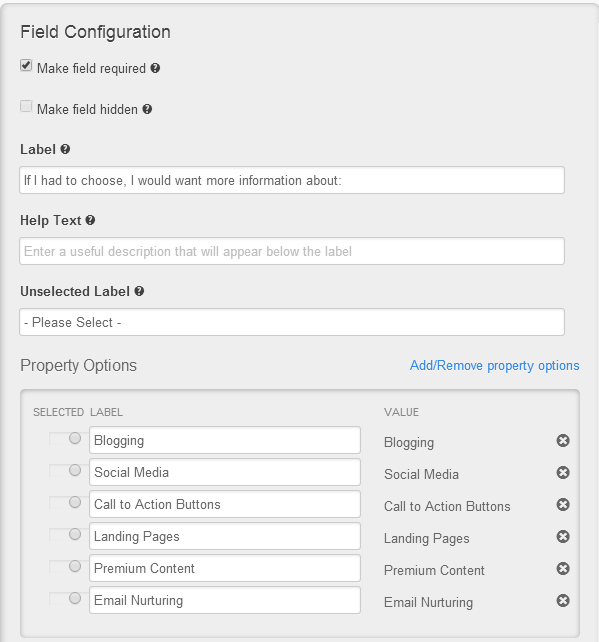 Once you've established your reputation as a marketer who delivers quality leads to sales, you'll be every sales person's best friend.
Once you've established your reputation as a marketer who delivers quality leads to sales, you'll be every sales person's best friend.
But not every new lead is destined to make a beeline to the bottom of your marketing funnel and request follow-up with a helpful, appreciative sales person.
And not every industry has a marketing funnel that lends itself well to online qualification beyond the initial consideration stage.
The consideration stage is the second of three stages in the buyer's journey. So what does the savvy inbound marketer do in the hazy, hazard strewn top of the funnel? What's the right model for sales and marketing alignment when a lead is actively considering your product, but not sure whether they are ready to commit?
Sales engagement at this stage is especially tricky because trust is only beginning to be established. Without the proper handling and information delivered to sales, your reputation for facilitating quality sales engagements can be in serious jeopardy.
Timing is Everything
If you have been following along with this mini-series of blog articles focused on sales and marketing alignment you know that our goal is to get marketing and sales working more effectively together to improve sales efficiency and the quality of sales engagements.
One of the biggest questions that bounces around between these two business functions is: “when should sales reach out to a lead”? If your answer is “always” then your sales people have long ago categorized your contributions as irrelevant for all the garbage leads they waste time following up with instead of playing nine holes with the real trophy prospects.
Last week we talked about helping set sales’ expectations when following up with leads at the awareness stage focus on providing information and context related to the problem the prospect is solving. But even in the best situations, using sales to pursue awareness stage leads can be inefficient and frustrating.
The relationship with the prospect is still very young and unless you have a household brand, there simply isn’t enough trust established to just dive in and start a meaningful conversation. Awareness stage leads require a lot of hand holding whether by inbound marketing or by direct sales engagement. In the consideration stage, the fun begins for sales, “the gloves are off” as they say.
But wait, just because the gloves are off doesn’t mean you go in swinging for the fences. Flailing around like an amateur, repeating awareness-stage questions, will only increase the risk of cooling off your warmed up leads.
Think about how a good boxer beats their opponent. They identify a soft-spot and they exploit it. The same tactic works for sales. Leads at the consideration stage still have their defenses up but they have revealed one or more soft spots, a specific interest in your product or solution, an unmet need or a preference for your brand.
Your job as an inbound marketer (sitting in the corner of the ring with your water bottle and smelling salts) is to help sales identify these soft spots so that they can focus on them without taking a lot of body blows or making wasteful windmill left hooks that never land.
Lets help sales get the most out of consideration stage leads!
Set Expectations With the Sales Team
Consideration stage leads are looking at your brand as a potential solution to their problems but they are also considering other solutions: competitive, complimentary, and substitutes. Sales should not expect to close a consideration-stage prospect on the first call.
The goal on that first call is to identify WHY the prospect is interested in your brand and the other solutions they are considering, and add value and build trust by helping the prospect understand their options and how each might affect their desired outcome.
Unlike awareness-stage leads, consideration-stage leads WILL have some specific questions about how your solution provides value and is competitively superior. Your sales team should be prepared to talk discuss these questions and as an inbound marketer, it’s your job to ensure that along with the lead contact information, sales has the relevant product information and competitive responses ready.
Ask Questions to Identify How THEY Think You Can Help Them
I used to make one particular mistake a lot when following up with consideration stage leads. I would be so ‘me focused’ that I’d jump right in and start the conversation by answering the question: “so what does your company do”? Answering this question before fully understanding the lead’s circumstances, their problem and their perceived value of your solution is equivalent to throwing big sloppy punches (to go back to the boxing analogy) and hoping one lands a knockout.
Why? If you drone on about what YOU think is valuable about your product or solution, but your prospect sees things differently (or worse, is indifferent to what you think is great and wonderful), you won’t be adding any value to the relationship and your “pitch” will fall flat at beast and sound like self-serving (instead of customer serving) chest beating at worst. Your consideration-stage lead doesn’t want a pitch, they want you to help them achieve a desired outcome.
Sales legend Geffrey Gitomer dedicates a whole chapter to adding value in the sales process in his book 21.5 Unbreakable Laws of Selling: “if your customer doesn’t see value in it, it isn’t valuable”. The simple rule is: figure out what is valuable to your prospect, the specific outcome they are looking to achieve, and focus your conversation on how you can work together to achieve that outcome.
How can inbound marketers help? Use marketing data to inform your sales team of the lead’s particular interest, their soft spot, ahead of time so they can be prepared to address and exploit the opportunity. At the end of the day, the prospect is in control of the conversation. Don’t break that rule by talking about product or services features that are not valuable to them.
In other words, don’t tell sales that your prediction is the only thing they are interested in. Your data is simply background information that the sales team can use at their own risk and reward.
Communicating Relevant Information About Leads to Sales
As an inbound marketer, you have all the tools you need to create a profile that qualifies a lead’s consideration-stage interest, but not all the information needs to be passed to sales at the consideration stage.
For leads in the consideration stage, the most valuable information you can pass along to sales is information that will help sales identify the prospect’s problem and desired outcome in the context of your brand and the competitive landscape in which your brand exists. This will help sales prepare to discuss your solution in both the specific context of the prospect’s needs, fears and objections and in the context of the competitive landscape.
For inbound marketers this information can easily be gathered through online forms. As part of your strategic planning you probably developed a list of perceived value points. Use this as a form field on your landing pages. For example: I have a form field on my landing pages that looks like this:

Go the Extra Mile, and Sales Will Love You Forever
If you want to put icing on the cake with sales, give them a map of all the content you have available on common problems that your audience will face. This way they have quick and easy access to the case studies, video testimonials, and product information that may address specific questions that come up on the call.
Send them a monthly update of the content map and use that as an excuse to check in with members of sales and ask about how their follow ups have been going with consideration stage leads. A couple good questions to ask sales would be:
- Are these leads really in the consideration stage?
- Are they actually interested in our offer?
- What other questions do you get?
- Are there topics that come up that you need content for?
- What other information would be helpful for you to reach out to these leads?
What other questions might you ask sales to help them follow up with consideration stage leads?

